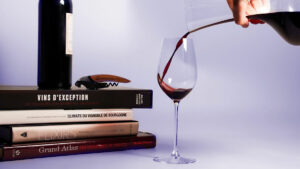
What’s the Perfect Serving Temperature for Your Wine?
Temperature plays a crucial role when it comes to serving and tasting wine. A single degree too high or too low and you’ve got a diplomatic incident on your hands, your Grand Cru is relegated to the second league and your popularity is benched. And yet, if you play by a few simple rules, you’ll pull off this balancing act every time!
THE THREE GOLDEN RULES
– Serve wines intended as apéritifs slightly more chilled.
– Opt for an ice bucket, even for red wine, but use it sparingly throughout the evening (unless you really want to recover the label).
– Do not exceed 18 °C; mulled wine is best left for après-ski, and even then, it’s debatable!
Different wines call for different temperatures, and each style of wine is best enjoyed at its own optimal serving and tasting temperature. It’s important to remember that wine gains around two degrees once poured into a glass, so keep this in mind when bringing your wine (in a bottle or decanter) to temperature.
This might seem a bit tedious at first, but just like any old grammar rule, once you get the hang of it, everything falls into place. Simply remember these two principles: cold temperatures tend to harden tannins and accentuate bitterness, while warm temperatures inhibit aromas and accentuate alcohol.
Here’s a handy table to help you reach the right serving and tasting temperatures.
Fine Wine
Bordeaux red wine: 17–18°
Burgundy red wine: 16°
Red wine not yet at its peak: 15-16°
Dry white wine: 13-14°
Light, fruity and young red wine: 13–14°
Rosé wine and En primeur wine: 10–12°
Dry white wine and Vins de Pays red wine: 10–12°
Easy-drinking white wine and Vins de Pays white wine: 8–10°
Champagne and Crémant: 7-8°
Non-vintage Champagne: 8°
Vintage Champagne: 10°
Old vintage Champagne: 12°
Sweet wine: 7-8°
ADJUSTMENTS NECESSARY FOR GOOD MEASURE
For older vintages, you should increase the recommended temperature by one or two degrees. For example, an old Burgundy should be served at 17°.
Because of its high sugar content, a sweet wine should ideally be served chilled, but not ice-cold, at around 8°. The higher the sugar content, the more complex the wine and the higher the temperature should be to release all its aromas. But be careful not to exceed 12°.
A young wine will tolerate one or two degrees less than a wine that’s reached its peak. That’s because these younger, fruitier wines are livelier and generally more acidic. We recommend you serve white wine between 9 and 12°, and red wine around 15°, or 12–13° if you are serving a light wine such as Gamay or Pinot Noir. The only exception to this rule is for robust, tannic red wine which, if served too cold, is likely to be perceived as hard, as the bitterness of its tannins will be accentuated.
White wine is generally drunk at cooler temperatures than red wine. However, this can vary depending on the grape variety, the age of the wine, and also the season. For instance, a light-red wine (produced from Gamay, as in Touraine or Beaujolais, or Pinot Noir, as in Alsace or Burgundy) should be served slightly chilled, at around 14°. Generally, these wines tend to be served even cooler during the summer months. A young wine will better handle a few degrees less than its older version, more inclined to tolerate 17–18° (never more; otherwise, the tannins become hard and bitter).
Every wine for sale on iDealwine includes a suggested temperature when serving.



